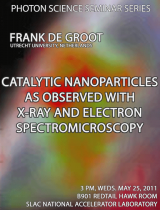Speaker: Frank de Groot, Utrecht University, Netherlands
Frank de Groot is professor of Synchrotron and Theoretical Spectroscopy of Catalytic Nanomaterials in the Department of Chemistry at Utrecht University. His work reflects a concern with the theoretical and the experimental aspects of x-ray spectroscopy, including both fundamental studies and applications. His current interest is in the use of x-ray spectroscopies for the study of the electronic and magnetic structure of condensed matter, in particular for transition metal oxides, (magnetic) nanoparticles and heterogeneous catalysts under working conditions.
Program Description
Transmission Electron Microscopy (TEM) has atomic resolution and can make accurate pictures of nanoparticles. Electron Energy Loss Spectroscopy (EELS) renders these pictures into element selective images.In principle EELS provides chemical information, but the necessity to measure under vacuum conditions limits the chemical determination of active or unstable systems.
Nanoscale chemical imaging of catalysts under working conditions is possible with Scanning Transmission X-ray Microscopy. We have shown that STXM can image a catalytic system under relevant reaction conditions and provides detailed information on the morphology and composition of the catalyst material in situ. The 20 nanometer resolution combined with powerful chemical speciation by XAS and the ability to image materials under reaction conditions opens up new opportunities to study many chemical processes. I will discuss the present status of in-situ STXM, with an emphasis on the abilities of the 20 nm resolution STXM technique in comparison with 0.1 nm STEM-EELS. Preliminary results from SSRL show that 10 bar in-situ STXM is also feasible at the iron K edge.
STXM-XAS and STEM-EELS provide a cross section of a nanoparticle. The interesting action takes place on a nanoparticle surface. Surfaces can be studied with XPS and using in-situ (10 mbar) XPS, the dynamic behaviour of nanoparticles can be imaged, Depending on the gas environment and temperature, the nanoparticle rearranges itself to its environment. In-situ XPS essentially learns which element is at the surface, but often gives limited information about the detailed chemical bonding. Recently we have performed Resonant Inelastic X-ray Scattering (RIXS) experiments of cobalt nanoparticles with trioctylphosphine oxide (TOPO) and oleic acid (OA) as surfactants. Measuring the optical dd-excitations at a core resonance, allows the study of the chemical bonding between a cobalt atom at the surface of a nanoparticle and its oxygen ligand from OA in great detail.





